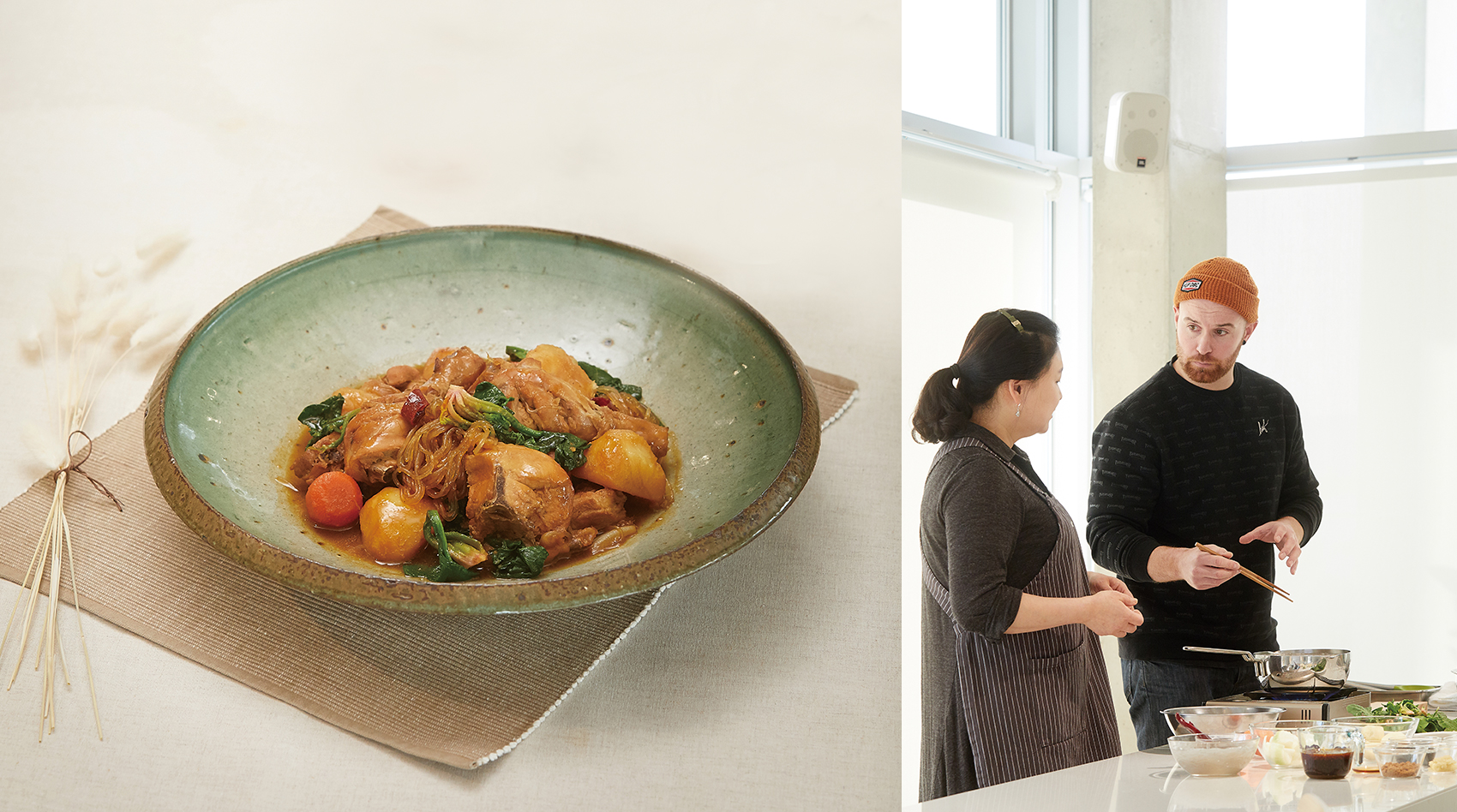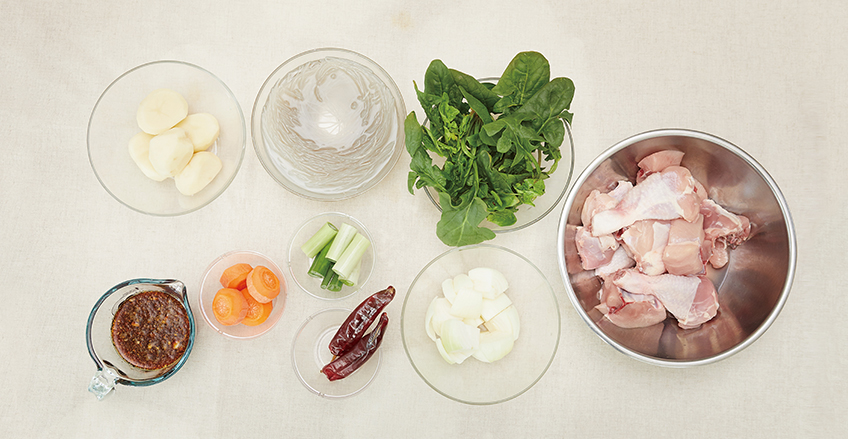

Jjimdak,
Korea’s Take on Chicken
A special treat for guests,
a snack to accompany alcoholic drink,
a local delicacy
It’s not uncommon for those unfamiliar with Korean cuisine to ask, “Why is braised chicken called Andong jjimdak if you can eat it anywhere outside of Andong?” If the dish had not been named after the city of Andong, visitors would probably find it less confusing. However, the name makes for a more interesting conversation at the dining table, giving visitors the opportunity to learn about the origins of the dish.
Written by Park Ji-yeon Photographed by Studio Kenn

Andong Jjimdak,
Originating From Andong?
When visitors are introduced to Andong jjimdak, the typical response is, “Is it a traditional dish from Andong?” This is what most would expect, since the dish is named after the city of Andong in Gyeongsangbuk-do Province. The city of origin is indeed Andong, but it’s not a traditional dish. Nonetheless, the popularity of jjimdak across Korea can be traced to Andong jjimdak.
In the late 1970s, there was one section of the market in Andong that sold fresh chicken. The merchants sold all kinds of chicken, both raw and cooked. When fried chicken sales went up, they tried to come up with new ways to make chicken more delicious. They chose a sweet and salty sauce for galbi grilled beef, a favorite among young and old. Andong jjimdak, or simply jjimdak as we know it today, was born by cooking some chicken in a galbi sauce.
The affordable and filling chicken dish became an instant hit. Naturally, the first thing that comes to mind today when we think of jjimdak is the city of Andong.

Jjimdak, Tourists’ Favorite Dish,
After Bulgogi
We asked Luke Hoagland, a jjimdak lover, to share with us some Korean dishes that are popular among his friends. He replied, “jjimdak!” When asked why, he said, “First of all, it tastes good. Then there’s the irresistible scent you get when cooking. The smell alone makes my mouth water.”
In one survey of tourists’ preferences for Korean food, bulgogi took the top spot, followed by jjimdak. What is it about jjimdak that appeals to visitors? Its sweet and salty sauce goes well with rice, and the spice balances out the greasy meat. The secret ingredient that won the hearts of all diners, however, is the glass noodles that soak up the flavorful gravy. Many tourists have a fondness for soy sauce-based glass noodles, found in dishes such as japchae stir-fried glass noodles and vegetables and bulgogi.

Perfect With Seasonal Vegetables
Hoagland, whose birthday is just around the corner, wants to cook jjimdak for his party this year. As an early birthday gift, we took him to a nearby cooking studio for a quick lesson. You can tell how much Hoagland enjoys jjimdak from his choice of spicy red chili peppers. Having lived in Korea for nine years, he said in fluent Korean that, “jjimdak is based on soy sauce, but the red chilies give it a hint of spice.” He brought the chilies close to his nose and took a whiff. He nodded as the instructor introduced the ingredients, but was surprised to see spinach instead of green onions, which are usually piled on top of the chicken.
Kim Seong-hee, the instructor of the day, said that, “Many people keep the doctor away by eating seasonal vegetables and fruits. Spinach is in-season until early spring. The ones with the red ends are sweet and delicious.”

jjimdak is made by boiling chunks of chicken in a galbi sauce. The chicken is cooked with various vegetables and glass noodles, and served in a huge bowl. It tastes great as long as you get the sauce right. Just be careful not to simmer it for too long. You don’t want to miss out on the delicious sauce.
While placing the braised chicken in a bowl, Hoagland said, “I can’t wait to mix the sauce with the rice!” His appetite couldn’t have been more stereotypically “Korean.” jjimdak is an easy, versatile dish that serves as a snack to accompany alcohol, a side dish to rice, as well as a special treat.
“Homemade Jjimdak?
Super great!”
Hoagland didn’t take long to make his own jjimdak. Because the chicken is boiled once and then simmered, the total cooking time is about 40 minutes. The glass noodles are soaked in cold water and added just two minutes before turning off the heat. As a side dish, Kim took out a jar of nabak kimchi, which is a type of water kimchi made with cabbages and radish. It can be eaten at any time of the year, especially in the spring. The sweet taste comes from the apples and pears, and there’s a punch of chili powder, too, stirred into the brine.


How does Hoagland’s first homemade jjimdak taste? After a bite of a drumstick, Hoagland exclaimed, “Super great!” It’s a phrase popularized by a local comedian. Hoagland had given his dish the best compliment he could possibly give it. He added that it was easier than expected, and planned to make it at home more often. Hoagland is confident that his girlfriend will enjoy the dish as much as he does when he cooks for her on his birthday. When asked why his girlfriend isn’t preparing the food, Hoagland replied that he loves to cook and wants to cook his favorite dish on his birthday. More than anything else, he wants to show his girlfriend that he is a man who knows how to cook jjimdak! Hoagland, who already knows how to cook his favorite Korean dishes like chadolbagi doenjangjjigae soybean paste stew with beef brisket and cheonggukjang rich soybean paste stew, can now add jjimdak to his list of signature dishes.
Cook Tip

1 kg chicken cut into chunks, 2 potatoes, ½ carrot, 1 onion, ½ stalk of green onion, 2 dried red chili peppers, one handful of spinach, two servings of glass noodles
* Add vegetables, rice cake, and cheese to taste.
Sauce
1½ cups water, ½ cups soy sauce, ¼ cups mirin cooking wine, 3 to 4 tablespoons raw sugar, 1½ tablespoons minced garlic,
½ tablespoons minced ginger, 1 tablespoon sesame oil, Ground black pepper
Other Articles


K-pop tomorrow

Sharing the Spotlight

Where Past Meets Present

para ice hockey player

well-designed things

Smart Technology, Services

Korea’s Take on Chicken


in Hong Kong
Application of subscription
Sign upThe event winners
Go


 March 2018
March 2018




